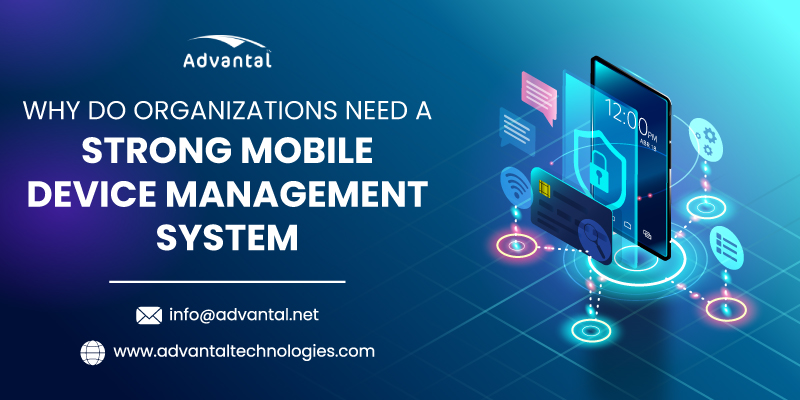The term mobile devices connote something personal. However, mobile devices are frequently used by employees to access work-related emails, files, etc. According to a report, 60% of the employees use smartphones for work.
However, this has also raised concerns about the logistics and security of the client and company data and communications. As mobile devices become increasingly common for work, the need for effective mobile device management will exist and evolve.
What is Mobile Device Management?
When we speak about Mobile Device Management (MDM) we mean software products that allow the IT security teams to control and secure company-owned and employee-owned mobile devices and enforce policies on them. They are analogous to RMM (Remote Monitoring & Management) tools, which IT teams use for the on-premise computers (desktops).
Why Is Mobile Device Management Important?
Most of the time, employees use their mobile devices outside the secured perimeter of the office. The office where the IT security teams guard and monitor the digital activities and incidents.
Organizations need a system in place to monitor, manage, and control company-owned and employee-owned devices. They also need these systems to be easy-to-use, compatible, and scalable. A holistic Mobile device management system resolves these issues.
Benefits of Mobile Device Management
A great tool for monitoring and controlling a fleet of mobile devices, MDM solutions provide numerous benefits, like:
- Monitor devices and applications remotely to ensure consistent support and functionality to the users (employees).
- Allow organizations to remotely diagnose and troubleshoot issues on the devices.
- Allow over-the-air distribution of apps, files, and other data to a fleet of devices.
- Facilitate configuration settings over the air.
- Enable remote backups to ensure the integrity of organizational and business data.
- Segmenting personal and company data on employee-owned devices.
- Remote deletion of files, applications, and data when the device is lost or the employee leaves the organization.
- Monitor compliance and diagnose devices through a centralized admin portal.
- Prevent unauthorized downloads and access to unauthorized websites to ensure data security and compliance.
- Protect confidential data through remote lock and wipe of devices, in case of theft or loss, as soon as it is reported.
Features of Mobile Device Management
MDM products help in mitigating security breaches and productivity roadblocks by monitoring and controlling mobile devices going out of the office premises. Let’s examine the most basic features of an ideal mobile device management solution:
1. Securing corporate data against public WiFi
Public WiFi spots, like a coffee shop, could be a potential den of cyber hackers, These hackers usually mask their WiFi to eavesdrop on vulnerable devices and read the e-mail communications.
To protect their employees, large firms usually have their private APN to provide enhanced security over 4G LTE and 5G networks – because it will not be shared with public connections. However, small to medium-sized companies usually cannot afford them. An MDM solution that can restrict the work-related devices from connecting to public WiFi protects the company data from eavesdropping and data theft.
2. Seamless Device Onboarding
Manually enrolling each device takes time and inhibits the IT team from doing other duties. MDM streamlines the device onboarding process for new employees and lets them get started on their work right away.
Using software solutions for mobile device management for android devices, organizations can connect, authenticate, and add devices via an over-the-air enrollment process.
3. Blocking Data Access of Rooted Devices
Rooting Android phones is risky because it lets employees install unauthorized applications and change the operating system of the device.
MDMs are programmed to detect rooted android devices and block data access to them.
4. Profile Customization & Management
For easier control, profiles are used to set standards and limits to devices. Admins can build separate profiles for corporate and employee-owned devices, which can then be installed on the devices during deployment.
Organizations can use an MDM solution to protect data against device theft, unsecured networks, rooting attempts, data breaches, and other risks.
5. Remote Control of Device Sensors
MDM also enables remote control of device sensors (like camera, microphone, speaker, screen, flash) on work-related mobile devices, which can further ensure the security of enterprise data.
6. Enforcing Password Policy and Device Encryptions
Mobile device management solutions apply encryption on mobile devices to obfuscate sensitive company information. They also enforce a strong password policy to protect the business data from theft.
7. App Distribution to Fleet Devices
IT admins can install and configure enterprise applications onto the work devices as soon as they are onboarded. MDM only allows installation and removal of applications through a custom-made enterprise application store onto the fleet devices. It does not require any intervention from the employee.
Managing and controlling applications from a centralized platform not only saves time for the IT teams but also boosts the productivity of the employees and the efficiency of the operations.
Final Thoughts
MDM solutions are becoming increasingly important. To choose the right product for your organization, check if the MDM software solution supports enterprise content management and cloud deliveries. Most importantly, the MDM solution should integrate flawlessly with the other service security management platforms of your organization.

